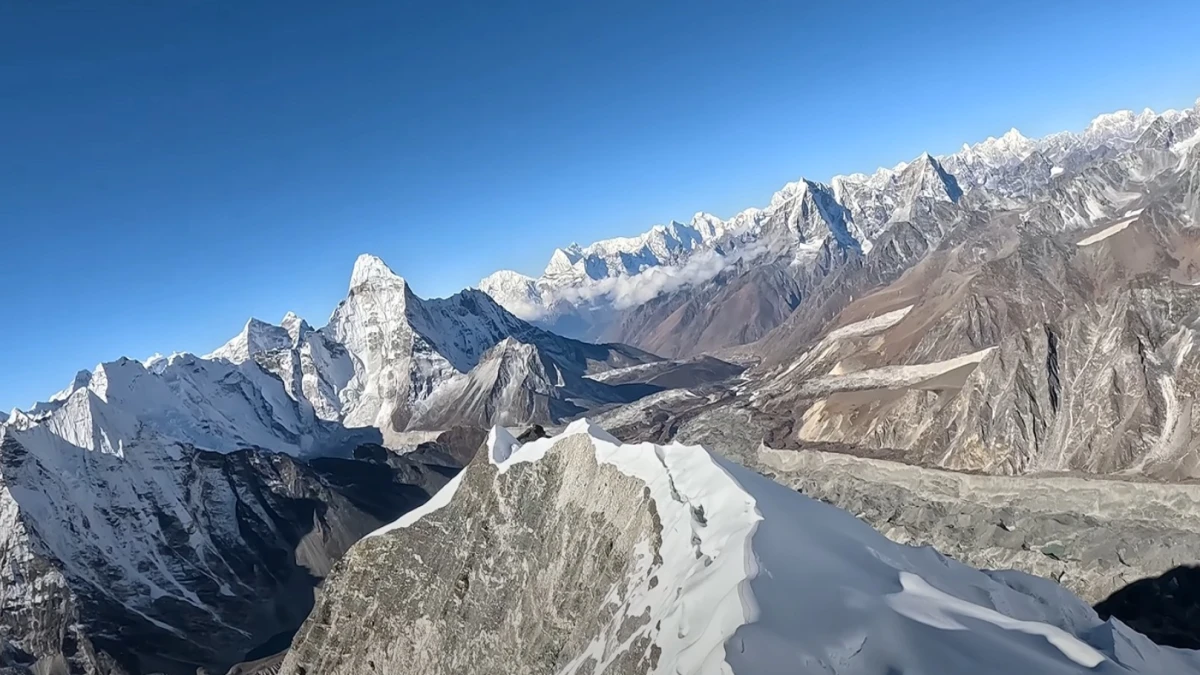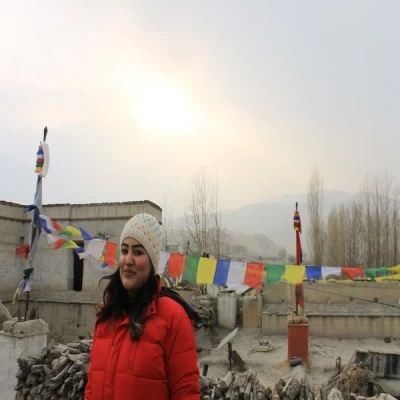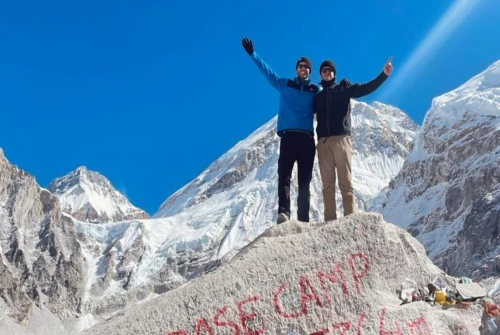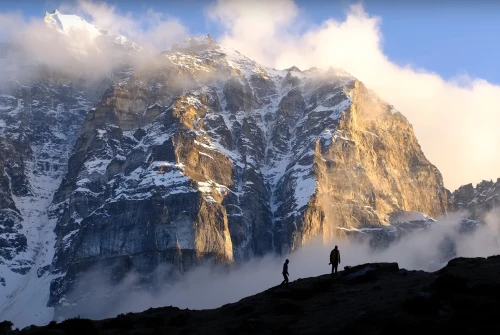The Everest Base Camp Trek in November is a journey that captures the very essence of Himalayan adventure. November is the last month of the autumn trekking season in Nepal, offering the perfect balance of clear skies, mild daytime temperatures, and breathtaking mountain views. With the monsoon long gone and the harsh winter yet to arrive, this is the ideal time to set foot on the trails leading to the world’s highest peak. Every step along the way greets us with dramatic landscapes, colorful Sherpa villages, and the unforgettable charm of the Khumbu region.
One of the biggest reasons trekkers choose November is the unparalleled visibility. The air is crisp and clean, making the snow-capped giants of the Himalayas shine more brilliantly than at any other time of year. Iconic peaks such as Mount Everest, Lhotse, Ama Dablam, and Thamserku dominate the skyline, and the golden sunrise views from vantage points like Kala Patthar feel almost otherworldly. The trails are vibrant with fellow trekkers, creating a lively yet warm atmosphere as people from around the world come together for the same dream, reaching the base of Mount Everest.
November also offers a wonderful blend of natural beauty and cultural encounters. As we trek through villages like Namche Bazaar, Tengboche, and Dingboche, we experience the rich Sherpa heritage and hospitality that make the journey even more meaningful. Tea houses are open and welcoming, providing hearty meals and cozy resting places after a long day’s walk. Some years, November also coincides with local festivals like Mani Rimdu, giving trekkers a rare chance to witness traditional Buddhist rituals in the heart of the Himalayas.
For those seeking both adventure and comfort, November is the sweet spot for the Everest Base Camp Trek. The trails are in excellent condition, the weather is reliable, and stunning landscapes and cultural immersion enrich the experience. With the right preparation, November offers everything a trekker dreams of: safe and stable conditions, unforgettable mountain views, and the pure joy of walking to the foot of the world’s tallest mountain.
Everest Base Camp Trek in November is one of the most rewarding adventures in Nepal, offering crisp mountain air, breathtaking Himalayan views, and favorable trekking conditions. As the last month of autumn, November is considered one of the best times of the year to trek to Everest Base Camp. The skies remain crystal clear, temperatures are moderate during the day, and the trails are lively with trekkers from all over the world. Let us take you through a detailed journey of what to expect, the weather, the highlights, and everything you need to prepare for this incredible adventure.
Why November is the Best Time for the Everest Base Camp Trek
November is part of Nepal’s peak trekking season, especially in the Everest region. During this month, the monsoon clouds have long disappeared, and the winter chill has not yet fully set in. This perfect balance creates ideal trekking conditions, making it a favorite choice for both first-time trekkers and experienced adventurers.
The biggest advantage of trekking in November is the panoramic visibility. Every morning greets us with a clear blue sky, and the snow-covered Himalayan giants like Mount Everest (8,848m), Lhotse (8,516m), Nuptse (7,861m), and Ama Dablam (6,812m) appear more spectacular than ever. Unlike the spring season, when haze sometimes obscures views, November offers a pristine, sharp outlook of the landscape.
Furthermore, November allows us to experience the vibrant trekking culture. Tea houses are buzzing with trekkers from all around the globe, exchanging stories and sharing warmth by the fire at night. This lively atmosphere adds an unforgettable social element to the trek.
Highlights of the Everest Base Camp Trek in November
1. Breathtaking Himalayan Views
The clarity of the Himalayan peaks in November is unmatched. Trekking under a bright blue sky, we are rewarded with mesmerizing views of Everest, Ama Dablam, Thamserku, Pumori, and Island Peak. Reaching vantage points like Kala Patthar (5,545m) gives us a panoramic perspective of Everest glowing golden under the morning sun.
2. Perfect Trail Conditions
November offers well-maintained and dry trails, making walking more comfortable. Unlike the summer monsoon when trails can be slippery, or winter when snow can block paths, November strikes the perfect balance. This makes it ideal for trekkers of all fitness levels.
3. Cultural Encounters
Along the way, we pass through Sherpa villages like Namche Bazaar, Tengboche, and Pangboche, where we experience the warm hospitality of the Sherpa people. Visiting Tengboche Monastery, one of the most spiritual sites in the region, is particularly memorable. November also coincides with local festivals such as Mani Rimdu in some years, offering a glimpse into authentic Himalayan traditions.
4. Teahouse Comfort
Since November is peak season, all tea houses are open and well-stocked. While it is busier, this ensures we always find hearty meals, hot drinks, and a cozy bed at the end of the day. The social atmosphere of shared dining rooms makes evenings cheerful and lively.
Challenges of Trekking in November
While November is one of the best months, there are still a few challenges we should prepare for:
- Cold Nights: Temperatures can drop significantly at night, so carrying a good-quality sleeping bag rated for -15°C is essential.
- Crowded Trails: Being peak season, the trails and teahouses can get crowded. Advance booking for accommodation is highly recommended.
- Altitude Sickness: November’s clear skies tempt many trekkers to push harder, but proper acclimatization is necessary to avoid AMS (Acute Mountain Sickness).
By being prepared with the right gear and following a gradual pace, these challenges are easily manageable.
Acclimatization and Safety Tips
To fully enjoy trekking in November, we must prioritize acclimatization and safety. It is important to follow the golden rule: climb high, sleep low. Taking rest days in places like Namche Bazaar (3,440m) and Dingboche (4,410m) ensures our body adjusts gradually to higher altitudes.
Staying hydrated is equally important in the dry November climate. Drinking at least 3–4 liters of water daily reduces the risk of altitude sickness. Trekking slowly, listening to our bodies, and descending immediately if symptoms worsen are crucial safety measures. Hiring an experienced guide and porter is highly recommended in November, not only for safety but also for cultural insight and logistical support.
Perfect Trekking Weather in November
November is defined by dry, stable, and crisp weather. Daytime temperatures at lower elevations like Lukla (2,860 m) and Namche Bazaar (3,440 m) range between 12°C to 16°C (54°F to 61°F), offering comfortable trekking conditions. As we ascend higher towards Dingboche (4,410 m), Lobuche (4,910 m), and Gorakshep (5,164 m), daytime temperatures drop but remain manageable, while nights get significantly colder, sometimes falling between -10°C to -12°C (14°F – 10°F).
The skies in November are almost always clear, ensuring spectacular Himalayan views from every corner of the trail. Rainfall is extremely rare, and snowfall is minimal compared to the harsher winter months of December and January. Trails are dry and stable, making them safe for trekking. The crisp mountain air also helps with acclimatization, reducing the risks of altitude sickness if we ascend gradually.
November days are slightly shorter, so it is advisable to start treks early in the morning to maximize daylight. This routine also rewards us with golden Himalayan sunrises that paint the mountains in breathtaking hues.
Stunning Himalayan Views in November
November is known for delivering the sharpest and most breathtaking Himalayan views. With post-monsoon clarity and dry autumn skies, mountains appear closer and more detailed than ever. Trekkers are rewarded with unobstructed panoramas of Everest (8,848 m), Lhotse (8,516 m), Nuptse (7,861 m), Ama Dablam (6,812 m), and Pumori (7,161 m).
Vantage points like Kala Patthar (5,545 m) become unforgettable highlights in November. Watching the first rays of the sun hit Mount Everest, turning it into a golden masterpiece, is a once-in-a-lifetime sight. Even throughout the trek, as we pass through valleys, ridges, and glacial landscapes, the crisp visibility makes every view stand out in extraordinary detail.
Photographers particularly favor November because of the vivid contrasts: deep blue skies, bright white snow, and the colorful prayer flags and Sherpa villages dotting the landscape. Every angle feels like a postcard scene waiting to be captured.
Accommodations and Food in November
Being the peak trekking season, all tea houses and lodges along the Everest trail are fully open and well-prepared for the influx of trekkers. Rooms are basic yet cozy, usually with twin beds, warm blankets, and shared bathrooms. While the nights are cold, the communal dining halls, often heated by yak-dung stoves, provide warmth and comfort.
Meals in November are plentiful, with tea houses offering both traditional Nepali dishes like dal bhat (rice and lentils), Sherpa stew, and momos, as well as popular international options such as pasta, fried rice, and pancakes. Hot drinks like ginger tea and hot chocolate are readily available and become a daily comfort against the evening chill.
Since November is a busy month, accommodations can fill up quickly, especially in popular villages like Namche Bazaar, Dingboche, and Gorakshep. Booking in advance or trekking with a guide who can reserve rooms is highly recommended.
Cultural & Village Highlights in November
Trekking in November is not just about mountains, it’s also about experiencing Sherpa culture at its liveliest. As we pass through villages like Namche Bazaar, Tengboche, Khumjung, and Pangboche, we see monasteries, prayer flags, mani walls, and chortens that reflect the deep spiritual life of the Sherpa people.
A major cultural highlight in some years is the Mani Rimdu Festival, held in Tengboche Monastery in late October or early November. This colorful Buddhist festival features masked dances, prayers, and rituals that attract both locals and trekkers. If our trek coincides with Mani Rimdu, it adds an extraordinary cultural layer to the adventure.
Sherpa hospitality is another highlight in November. Tea houses are lively with conversations, laughter, and cultural exchange as trekkers from around the world gather in dining halls, sharing meals and stories under the warmth of traditional stoves.
Weather and Temperature in November for Everest Base Camp Trek
Here’s a detailed breakdown of November weather at different elevations:
Elevation | Daytime Temp (°C) | Nighttime Temp (°C) | Typical Conditions |
Lukla (2,860 m) | 12–16°C | 2–6°C | Mild and sunny, pleasant trekking conditions with lush greenery fading into autumn tones. |
Namche Bazaar (3,440 m) | 8–14°C | 0–4°C | Cool days, chilly nights; clear skies perfect for mountain views. |
Dingboche (4,410 m) | 5–10°C | -4 to -8°C | Noticeably colder; dry trails with bright sun during the day. |
Everest Base Camp (5,364 m) | 0–6°C | -10 to -12°C | Cold and dry, excellent visibility; nights are freezing, but skies are clear. |
Early November: Milder temperatures, busy trails, festive atmosphere.
Mid-November: Stable and cool, the best balance of views and weather.
Late November: Much colder nights as winter approaches, fewer trekkers, but trails remain open and skies clear.
How to Prepare for an Everest Base Camp Trek in November
- Clothing & Gear: Pack in layers: thermal base layers, fleece, an insulated down jacket, and a waterproof shell. A four-season sleeping bag (-15°C rating) is essential for cold nights.
- Fitness: Build stamina with cardio training, uphill hikes, and practice carrying a backpack.
- Acclimatization: Spend acclimatization days in Namche Bazaar and Dingboche to adapt to the altitude.
- Permits: Obtain the Sagarmatha National Park Entry Permit and Khumbu Pasang Lhamu Rural Municipality Fee before starting the trek.
- Guides & Porters: Highly recommended for navigation, logistics, and cultural insights during this busy season.
- Insurance: Must cover high-altitude trekking and emergency helicopter evacuation.
Essential Tips for Trekking to Everest Base Camp in November
- Start early each trekking day to maximize daylight and avoid cold evenings.
- Book accommodations in advance during the peak trekking weeks.
- Stay hydrated and avoid alcohol to reduce the risk of altitude sickness.
- Carry cash in Nepali rupees as ATMs are only available in Lukla and Namche Bazaar.
- Respect local culture by learning basic Nepali phrases and following responsible trekking practices.
Essential Packing List for November
Packing wisely makes all the difference for a comfortable trek in November. Here are the essentials:
- Clothing: Thermal base layers, fleece jackets, down jacket, trekking pants, waterproof shell jacket, gloves, woolen hat, buff, and trekking socks.
- Footwear: Sturdy waterproof trekking boots, gaiters, and camp shoes.
- Sleeping Gear: Four-season sleeping bag (rated at least -15°C).
- Accessories: Sunglasses with UV protection, sunscreen, lip balm, trekking poles, headlamp, and water purification tablets.
- Medications: Altitude sickness tablets (Diamox), pain relievers, and a personal first aid kit.
Layering is key in November since mornings and evenings are cold, while afternoons can be warm during trekking.
FAQs for Everest Base Camp Trek in November
Is November a good month to trek to Everest Base Camp?
Yes, November is one of the best months with clear skies, stunning mountain views, stable weather, and lively trails.
How cold is it in November on the EBC trek?
Daytime is mild (5–15°C), but nights above 4,000 m can drop to -10°C or lower. Proper winter gear is essential.
Do I need to book accommodation in advance in November?
Yes, since November is peak season, tea houses fill up quickly. Pre-booking ensures availability.
What festivals occur in November?
Some years, the Mani Rimdu Festival in Tengboche Monastery falls in November, offering a unique cultural experience.
Will there be snow in November?
Light snow is possible at higher elevations, but trails are generally dry and open.
Final Thoughts
The Everest Base Camp Trek in November is truly an experience of a lifetime. With stable weather, incredible visibility, cultural vibrancy, and the perfect trekking conditions, November stands out as the best month to embark on this adventure.
From the bustling Sherpa villages to the icy winds at Everest Base Camp itself, every moment in November is filled with awe and inspiration. The combination of majestic mountain views, crisp autumn air, and the warmth of Sherpa hospitality makes this trek unforgettable. If you dream of walking in the footsteps of legendary climbers and standing at the base of the world’s highest mountain under crystal-clear skies, then November is the time to make it happen.
The Everest Base Camp Trek in November is a life-changing experience that combines crystal-clear Himalayan views, comfortable weather, vibrant trekking culture, and the pure thrill of being in the lap of the world’s highest mountain. November offers the perfect blend of adventure and safety, making it the ideal time for both first-time trekkers and seasoned adventurers.
From the crisp mornings in Lukla to the breathtaking sunrise over Everest from Kala Patthar, every step of the journey in November is filled with awe and wonder. With proper preparation, the right gear, and a spirit of adventure, we can turn this trek into one of the most memorable experiences of our lifetime.


.webp)

